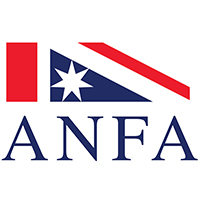Parliamentary Resolution
House of Representatives
Mr Anderson (Gwydir – Minister for Transport and Regional Services) (5.57 p.m.)
Mr Speaker, on behalf of the Prime Minister, I move:
That this House:
- recognises and celebrates the centenary of the Australian National Flag which occurs on 3 September this year;
- honours the ideals for which our national flag stands including our history, geography and unity as a federated nation;
- notes that this is the world’s only national flag ever to fly over one entire continent;
- acknowledges that our flag has been Australia’s pre-eminent national symbol in times of adversity and war, peacetime and prosperity;
- recognises that our flag now belongs to the Australian people and has been an integral part of the expression of our national pride; and
- expresses its respect for the Australian National Flag as a symbol of our profound achievements as a federation; our independence and freedom as a people; and our optimism for a common future together.
I am very pleased to speak in support of the Prime Minister’s motion, celebrating the centenary of the Australian National Flag. In April 1901 the government announced a competition to design the flag. It received over 32,000 entries. The judges chose five designs that were almost identical and split the prize among the winners. Those five designs form the basis of the flag that we celebrate today.
I think it is only appropriate that I should pay tribute to the contest winners, those five men and women who designed our best known national symbol. They were Anne Dorrington, who became a famous artist; Ivor Evans, a 14-year-old with a taste for Dante; William Stephens, the first officer on a steamship; Egbert Nuttall, a municipal architect; and Leslie Hawkins, an optician’s apprentice.
After the decision on what it would look like was announced by Prime Minister Barton, the flag flew for the first time on 3 September 1901. It floated above the dome of the Exhibition Building in a strong south-westerly breeze. It was, according to the Melbourne Age, a brave and inspiring picture.
Since 1901, the flag has been flown in war and in peace, in adversity and in prosperity. It flew over Charleroi in Belgium in 1918 when the 2nd Division of the Australian Corp entered the city. The citizens of the town had made it from brown paper, and they offered our troops the use of the local university as a training centre. It flew over the X3 working camp in Singapore after the Japanese surrender; it had been made in secret by Australian prisoners of war, using handkerchiefs from Red Cross parcels.
I know that there has been very strong support in the Australian community for an action taken by this government in 1998 when we amended the Flags Act to ensure that the flag could not be changed unless a national vote of the people supported an alternative design. This guaranteed that the Australian flag was properly recognised as being the property of all Australians–not of Canberra, not of members of parliament.
Also of note is the fact that it is the only flag in the world that flies, or has ever flown, over an entire continent. Until the independence of Papua New Guinea in 1975, it flew over Australian territory from the equator to the geographic South Pole. In fact, it still flies today at the South Pole with the flags of other members of the Antarctic Treaty. It was broadcast around the world at a very proud time for Australia, and that was during the Sydney Olympics. It flies above Parliament House tonight as an enduring symbol of our achievements together and of our common future. I commend the motion to the House.
Senate
Leader of the Government in the Senate (Senator Hill): To move that the Senate:
- recognises and celebrates the centenary of the Australian National Flag which occurs on 3 September this year;
- honours the ideals for which our national flag stands including our history, geography and unity as a federated nation;
- notes that this is the world’s only national flag ever to fly over one entire continent;
- acknowledges that our flag has been Australia’s pre-eminent national symbol in times of adversity and war, peacetime and prosperity;
- recognises that our flag now belongs to the Australian people and has been an integral part of the expression of our national pride; and
- expresses its respect for the Australian National Flag as a symbol of our profound achievements as a federation; our independence and freedom as a people; and our optimism for a common future together.
These resolutions were agreed to on 30 August 2001.
